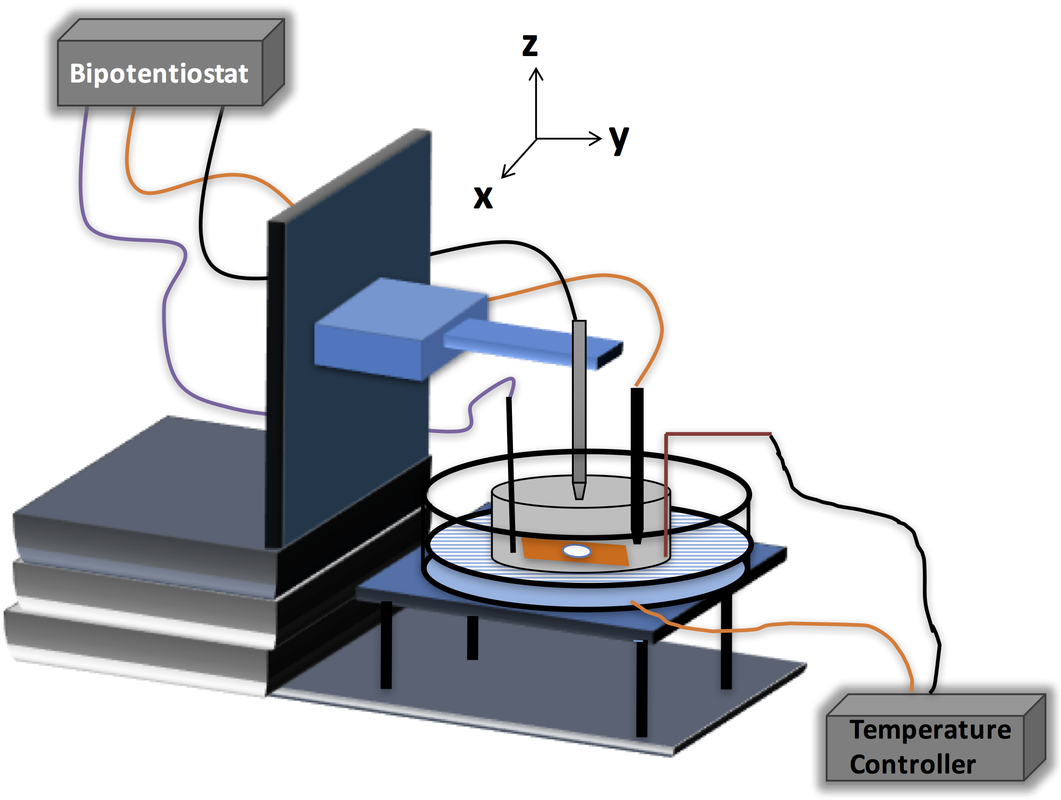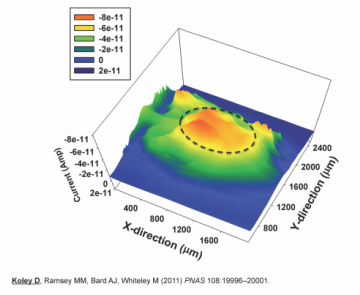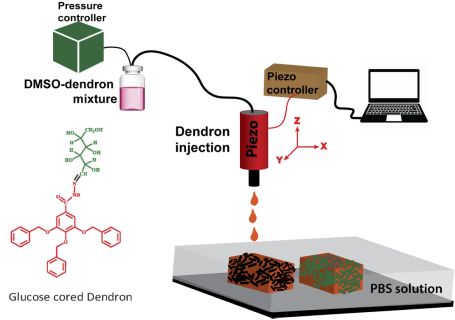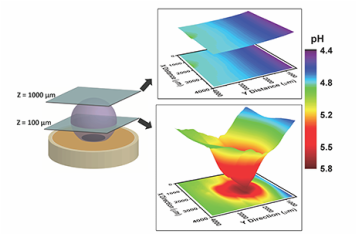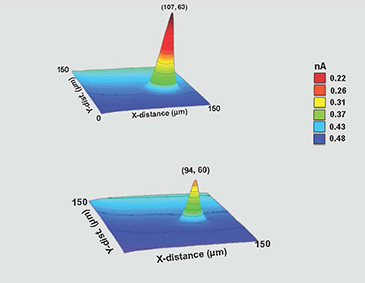Research
Our lab is interested in developing new electrochemical tools to study microbial metabolism at high spatial and temporal resolution. We are specifically interested in studying bacterial metabolic interactions among bacterial species, biomaterials, mammalian cells or immediate microenvironment surrounding the bacteria. We use our expertise in designing and fabricating electrochemical sensors to assist life scientist and restorative dentist in studying, diagnosing and intervening with preventive measures of various human diseases. Current area of interest includes:
- Biofilms
- 3D Hydrogel Printing
- Restorative Dental Materials and Biofilms
- Bacterial Mediated Bio-cement Formation
- Single Cell Migration
A. Biofilms
Our main focus is to develop novel electrochemical techniques to investigate new frontiers in microbiology, such as the social behavior of microbes, otherwise known as quorum sensing. This collective behavior of bacteria, or quorum sensing, plays an important role in forming biofilm, which ultimately helps bacteria collectively overcome many adverse environmental conditions, including the increased microbial resistance to antibiotics. We are interested in using new electrochemical techniques such as scanning electrochemical microscopy (SECM) to study the microbial metabolites exchange in real-time and in 3D space to elucidate the microbial behavior in the context of biofilm-related diseases and infections in/on biomedical devices (catheters, artificial heart valves etc.). These findings will ultimately lead us to design the next generation smart biomedical devices.
Our main focus is to develop novel electrochemical techniques to investigate new frontiers in microbiology, such as the social behavior of microbes, otherwise known as quorum sensing. This collective behavior of bacteria, or quorum sensing, plays an important role in forming biofilm, which ultimately helps bacteria collectively overcome many adverse environmental conditions, including the increased microbial resistance to antibiotics. We are interested in using new electrochemical techniques such as scanning electrochemical microscopy (SECM) to study the microbial metabolites exchange in real-time and in 3D space to elucidate the microbial behavior in the context of biofilm-related diseases and infections in/on biomedical devices (catheters, artificial heart valves etc.). These findings will ultimately lead us to design the next generation smart biomedical devices.
B. 3D Hydrogel Printing
Hydrogels are network of polymeric chains which are capable of absorbing high volume of water. These natural or synthetic polymeric chain networks exhibit properties very similar to tissues and have been used in various biomedical applications including tissue engineering, creating wound healing patches, and drug delivery, etc. We are involved in synthesizing a variety of dendron molecules and their analogs to tune their property for potential applications in small molecule delivery to living cell preservation. We are also using our newly synthesized glucose modified dendron molecules to fabricate unique 3D printing hydrogel for bacteria encapsulation.
Hydrogels are network of polymeric chains which are capable of absorbing high volume of water. These natural or synthetic polymeric chain networks exhibit properties very similar to tissues and have been used in various biomedical applications including tissue engineering, creating wound healing patches, and drug delivery, etc. We are involved in synthesizing a variety of dendron molecules and their analogs to tune their property for potential applications in small molecule delivery to living cell preservation. We are also using our newly synthesized glucose modified dendron molecules to fabricate unique 3D printing hydrogel for bacteria encapsulation.
C. Restorative Dental Materials and Biofilms
Secondary caries is the major problem in restorative dentistry. One of the major causes for such failure is the lack of detailed understanding of bacterial growth at the interface of dental composites and the host tooth. Our lab is currently studying the Streptococcus. gordonii and the Streptococcus. mutans bacterial biofilm metabolism phenomenon inside a dental crevice-like environment. We use varied type of ultramicrosensors to measure the bacterial metabolites at high temporal and spatial resolution. The ultimate goal of this project is to use our fundamental findings to aid the development of next generation smart dental composites.
Secondary caries is the major problem in restorative dentistry. One of the major causes for such failure is the lack of detailed understanding of bacterial growth at the interface of dental composites and the host tooth. Our lab is currently studying the Streptococcus. gordonii and the Streptococcus. mutans bacterial biofilm metabolism phenomenon inside a dental crevice-like environment. We use varied type of ultramicrosensors to measure the bacterial metabolites at high temporal and spatial resolution. The ultimate goal of this project is to use our fundamental findings to aid the development of next generation smart dental composites.
D. Bacterial Mediated Bio-cement Formation
Sporosarcina pasteurii bacteria are known to hydrolyze urea and thus, change the local pH to more basic value such that it facilitates the precipitation of calcium ions present in the solution as calcium carbonate. At the initial stage of this precipitation process, the bacterial surface acts as a nucleation site and gets gradually coated with precipitated calcium carbonate until the layer is thick enough to prohibit the hydrolysis process. Wide variety of applications such as restoration of historical monuments, building eco-friendly houses in Sahara deserts, sealing cracks inside oil well concrete and rock interface, etc. have been developed in recent years harnessing the unique capabilities of these bacteria. Our lab primary focuses on studying this bio-mediated calcification process using pH and Ca2+ monitoring SECM probes.
Sporosarcina pasteurii bacteria are known to hydrolyze urea and thus, change the local pH to more basic value such that it facilitates the precipitation of calcium ions present in the solution as calcium carbonate. At the initial stage of this precipitation process, the bacterial surface acts as a nucleation site and gets gradually coated with precipitated calcium carbonate until the layer is thick enough to prohibit the hydrolysis process. Wide variety of applications such as restoration of historical monuments, building eco-friendly houses in Sahara deserts, sealing cracks inside oil well concrete and rock interface, etc. have been developed in recent years harnessing the unique capabilities of these bacteria. Our lab primary focuses on studying this bio-mediated calcification process using pH and Ca2+ monitoring SECM probes.
E. Cell Migration
Collective migration plays a crucial role in embryonic morphogenesis, tissue homeostasis as well as contributing to the several important pathological processes, such as cancer invasion and metastasis formation, etc. However, studying the collective migration does not provide any information about the migratory mechanism or the biomechanics of an individual cell. Therefore, studying the mechanism(s) of cellular migration at the single-cell level is important for in-depth understanding of the basic biology underlying both homeostasis and pathological conditions. Single-cell migration is a complex, multistep process that is generally initiated by protrusion of the cell membrane, driven by actin polymerization, and further stabilized by adhesion to the extracellular matrix, depending on the cell’s morphological, structural, and functional characteristics. In our lab we are interested in studying biomechanical properties of a single cell and its relationship with the chemical cues at spatial-temporal context.
Collective migration plays a crucial role in embryonic morphogenesis, tissue homeostasis as well as contributing to the several important pathological processes, such as cancer invasion and metastasis formation, etc. However, studying the collective migration does not provide any information about the migratory mechanism or the biomechanics of an individual cell. Therefore, studying the mechanism(s) of cellular migration at the single-cell level is important for in-depth understanding of the basic biology underlying both homeostasis and pathological conditions. Single-cell migration is a complex, multistep process that is generally initiated by protrusion of the cell membrane, driven by actin polymerization, and further stabilized by adhesion to the extracellular matrix, depending on the cell’s morphological, structural, and functional characteristics. In our lab we are interested in studying biomechanical properties of a single cell and its relationship with the chemical cues at spatial-temporal context.

